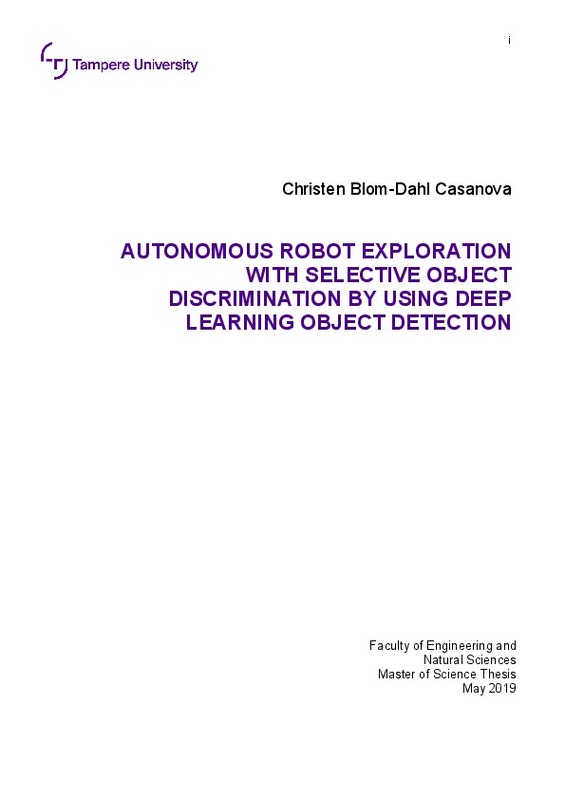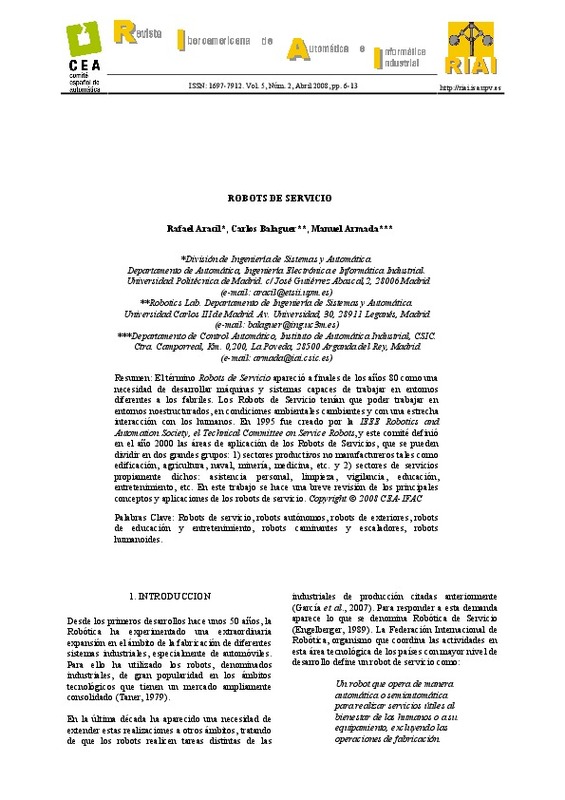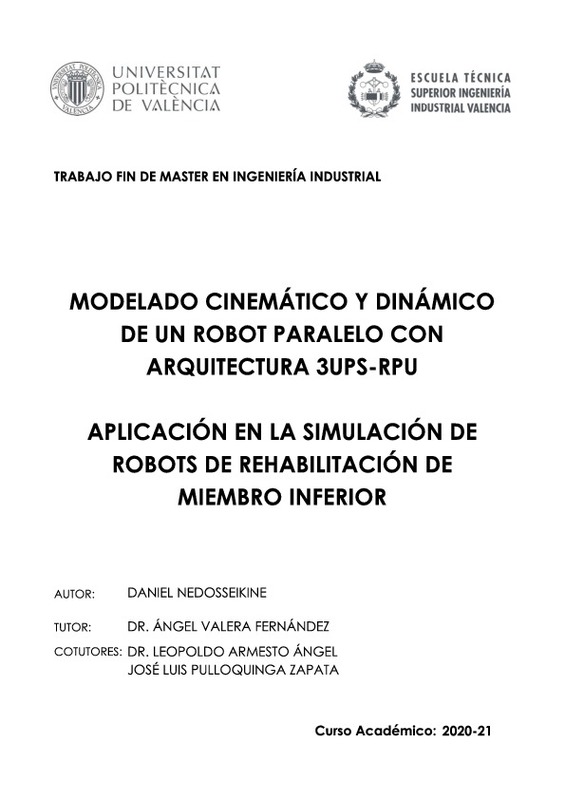JavaScript is disabled for your browser. Some features of this site may not work without it.
Buscar en RiuNet
Listar
Mi cuenta
Estadísticas
Ayuda RiuNet
Admin. UPV
ESTUDIO Y DESARROLLO DE EXPLORACIÓN ROBÓTICA AUTÓNOMA CON DISCRIMINACIÓN SELECTIVA DE OBJETOS MEDIANTE EL USO DE DETECCIÓN DE OBJETOS DE APRENDIZAJE PROFUNDO
Mostrar el registro sencillo del ítem
Ficheros en el ítem
| dc.contributor.advisor | Sánchez Salmerón, Antonio José
|
es_ES |
| dc.contributor.author | Blom-Dahl Casanova, Christen
|
es_ES |
| dc.date.accessioned | 2020-03-30T17:33:27Z | |
| dc.date.available | 2020-03-30T17:33:27Z | |
| dc.date.created | 2019-07-17 | |
| dc.date.issued | 2020-03-30 | es_ES |
| dc.identifier.uri | http://hdl.handle.net/10251/139822 | |
| dc.description.abstract | [ES] Dado que el mundo geopolítico ya no está polarizado, la competitividad del mercado aumenta como nunca antes para sobrevivir como organización industrial, es clave ser competitivo. Es decir, reduciendo costos y tiempos de producción entre otras necesidades. Los robots móviles son recursos que consiguen aliviar esas necesidades ya que pueden sustituir a los humanos y tener un mejor rendimiento. Esto provoca una caída casuística de los problemas humanos, la reasignación de recursos humanos a puestos de trabajo más creativos que no pueden ser reemplazados por robots, y una mayor eficiencia a largo plazo. El estado del arte del uso de los robots móviles se basa en el hecho de que estamos hablando no sólo de un único robot móvil, sino de una flota de ellos que funciona de forma inteligente y coordinada. Estos dispositivos pueden integrarse en la cadena de suministro para poder transportar cargas útiles sin necesidad de intervención humana. Además, esta integración permite una gran flexibilidad, ya que los robots móviles industriales inteligentes pueden adaptarse a nuevas condiciones, parámetros impuestos y obstáculos que no estaban previstos. Para cualquier robot móvil autónomo, es necesario un conocimiento previo de su entorno antes de realizar una navegación autónoma, es decir, tener un mapa previo. La cartografía suele ser una tarea intervenida por el hombre que lleva tiempo, especialmente en el caso de las grandes instalaciones. Este trabajo propone una forma de mapear autónomamente, de la manera más eficiente, un ambiente interior 2D utilizando el enfoque de Árboles aleatorios de exploración rápida, ya que está sesgado hacia regiones desconocidas. Además, este trabajo propone la discriminación de objetos durante el mapeo. Con el enfoque convencional, durante el proceso de mapeo, los escáneres láser leen la presencia de todos los obstáculos en el entorno. Este hecho es indeseable, ya que algunos de estos obstáculos escaneados son escaneados sólo por causalidad durante la exploración (por ejemplo, el personal, los equipos móviles industriales, etc.). Estos datos no deseados registrados en el mapa suponen ruido y no representan el entorno real a largo plazo. La implementación de la eliminación de este tipo de ruido se gestiona mediante la combinación de dos módulos. Por un lado, mediante el uso de herramientas de aprendizaje profundo de última generación para lograr la detección de objetos en tiempo real. Por otro lado, un filtro al escáner láser para que sea ciego ante tales detecciones durante la exploración, por lo que nunca se registran en el mapa. Los resultados muestran un gran potencial de resultados de alta calidad que están intrínsecamente asociados con el módulo detector de objetos. Dado que este módulo es de última generación, la tecnología está en constante desarrollo y mejora no sólo en cuanto a rendimiento, sino también en cuanto a flexibilidad y capacidades. Este trabajo es un nuevo y potencial enfoque de alta fidelidad, además del enfoque convencional, para llevar a cabo la exploración con robots móviles. | es_ES |
| dc.description.abstract | [EN] Since the geopolitical world is not polarized anymore, the market competitivity is increasing as never before so in order to survive as an industrial organization, it is key to be competitive. That is, reducing costs and production times among other needs. Mobile robots are resources that manage to get those needs relieved since they can substitute humans and perform better. This causes human issues casuistic drop, human resources re-allocation in more creative job positions which cannot replaced by robots, and more long-term efficiency. The state-of-the-art of the use of mobile robots remains on the fact that we are talking about not just a single mobile robot but a fleet of them which performs in a smart and coordinated way. These devices can be integrated in the supply-chain so that can transport payloads without the need of any human intervention. In addition, such integration allows a huge flexibility since smart industrial mobile robots can adapt to new conditions, imposed parameters and obstacles that were not predicted. For any autonomous mobile robot, a prior knowledge about its environment is necessary before performing autonomous navigation, that is to have a previous map. Mapping usually is a human intervened task which takes time, especially for large facilities. This work proposes a way to map autonomously, in the most efficient way, an indoor 2D environment by using the Rapidly-exploring Random Trees approach since it is biased towards unknown regions. In addition, this work proposes object discrimination during mapping. With the conventional approach, during the mapping process laser scanners read the presence of all the obstacles in the environment. This fact is undesired since some of such scanned obstacles are scanned just by causality during the exploration (e.g. personnel, industrial mobile equipment ). Such undesired registered data in the map suppose noise and does not represent the actual long-term environment. The implementation of removing such noise is managed by the combination of two modules. On one hand, by using state-of-the-art deep learning tools in order to achieve real-time object detection. On the other hand, a filter to the laser scanner so that it is blind towards such detections during the exploration, so they are never registered on the map. The results show quite potential high-quality results which are intrinsically associated with the object detector module. Since such module is state-of-the-art, the technology involved is constantly developing and improving not just the performance but also flexibility and capabilities. This work is a potential new high-fidelity approach besides the conventional approach in order to perform mobile robot exploration. | es_ES |
| dc.language | Inglés | es_ES |
| dc.publisher | Universitat Politècnica de València | es_ES |
| dc.rights | Reserva de todos los derechos | es_ES |
| dc.subject | Exploración | es_ES |
| dc.subject | Árbol aleatorio de exploración rápida | es_ES |
| dc.subject | RRT | es_ES |
| dc.subject | Exploración de robots | es_ES |
| dc.subject | Escáner La-ser | es_ES |
| dc.subject | MiR | es_ES |
| dc.subject | Robot móvil industrial | es_ES |
| dc.subject | No Estructural | es_ES |
| dc.subject | Mapeo | es_ES |
| dc.subject | Sistema Operativo de Robots | es_ES |
| dc.subject | ROS | es_ES |
| dc.subject | Visión por Computadora | es_ES |
| dc.subject | OpenCV | es_ES |
| dc.subject | SLAM | es_ES |
| dc.subject | Cámara Estéreo | es_ES |
| dc.subject | Intel Re-alSense | es_ES |
| dc.subject | Nube de Puntos | es_ES |
| dc.subject | Aprendizaje Profundo | es_ES |
| dc.subject | Detección de Objetos | es_ES |
| dc.subject | Modelos Pre-entrenados | es_ES |
| dc.subject | Aprendizaje de Transferencia | es_ES |
| dc.subject | Rastreo en 3D | es_ES |
| dc.subject | Localización en 3D | es_ES |
| dc.subject | Visión por Máquina | es_ES |
| dc.subject | Percepción de Robots | es_ES |
| dc.subject | Exploration | es_ES |
| dc.subject | Rapidly-exploring Random Tree | es_ES |
| dc.subject | Robot exploration | es_ES |
| dc.subject | La-ser Scanner | es_ES |
| dc.subject | Industrial Mobile Robot | es_ES |
| dc.subject | Non-Structural | es_ES |
| dc.subject | Mapping | es_ES |
| dc.subject | Robot Operating System | es_ES |
| dc.subject | Computer Vision | es_ES |
| dc.subject | Stereo Camera | es_ES |
| dc.subject | Pointcloud | es_ES |
| dc.subject | Deep Learning | es_ES |
| dc.subject | Object Detection | es_ES |
| dc.subject | Pretrained Models | es_ES |
| dc.subject | Transfer Learning | es_ES |
| dc.subject | 3D Tracking | es_ES |
| dc.subject | 3D Localization | es_ES |
| dc.subject | Machine Vision | es_ES |
| dc.subject | Robot Perception | es_ES |
| dc.subject.classification | INGENIERIA DE SISTEMAS Y AUTOMATICA | es_ES |
| dc.subject.other | Máster Universitario en Ingeniería Industrial-Màster Universitari en Enginyeria Industrial | es_ES |
| dc.title | ESTUDIO Y DESARROLLO DE EXPLORACIÓN ROBÓTICA AUTÓNOMA CON DISCRIMINACIÓN SELECTIVA DE OBJETOS MEDIANTE EL USO DE DETECCIÓN DE OBJETOS DE APRENDIZAJE PROFUNDO | es_ES |
| dc.type | Tesis de máster | es_ES |
| dc.rights.accessRights | Abierto | es_ES |
| dc.contributor.affiliation | Universitat Politècnica de València. Departamento de Ingeniería de Sistemas y Automática - Departament d'Enginyeria de Sistemes i Automàtica | es_ES |
| dc.contributor.affiliation | Universitat Politècnica de València. Escuela Técnica Superior de Ingenieros Industriales - Escola Tècnica Superior d'Enginyers Industrials | es_ES |
| dc.description.bibliographicCitation | Blom-Dahl Casanova, C. (2019). ESTUDIO Y DESARROLLO DE EXPLORACIÓN ROBÓTICA AUTÓNOMA CON DISCRIMINACIÓN SELECTIVA DE OBJETOS MEDIANTE EL USO DE DETECCIÓN DE OBJETOS DE APRENDIZAJE PROFUNDO. http://hdl.handle.net/10251/139822 | es_ES |
| dc.description.accrualMethod | TFGM | es_ES |
| dc.relation.pasarela | TFGM\113122 | es_ES |
Este ítem aparece en la(s) siguiente(s) colección(ones)
-
ETSII - Trabajos académicos [9890]
Escuela Técnica Superior de Ingenieros Industriales









